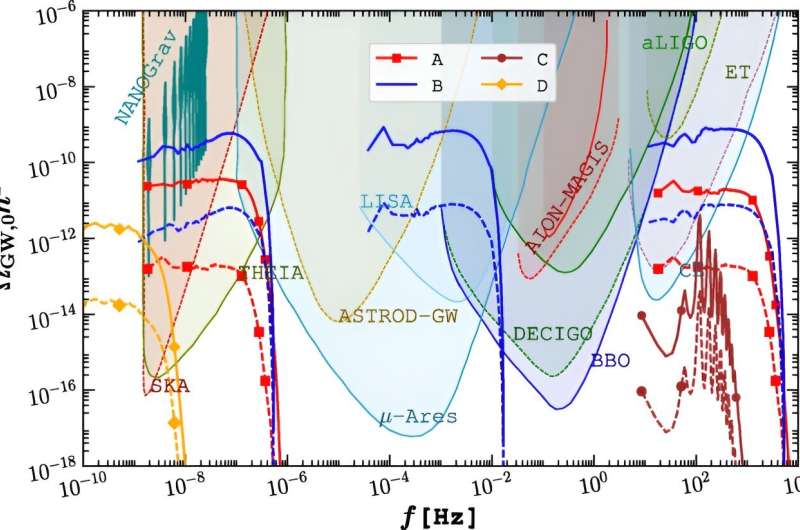This article has been reviewed according to Science X's editorial process and policies. Editors have highlighted the following attributes while ensuring the content's credibility:
fact-checked
peer-reviewed publication
trusted source
proofread
Q&A: Researcher discusses how gravitational waves hint at dark matter and Big Bang mysteries

Gravitational waves, ripples in space-time predicted by Einstein almost a century ago, were detected for the first time in 2015. A new study led by Yanou Cui, an associate professor of physics and astronomy at the University of California, Riverside, reports that very simple forms of matter could create detectable gravitational wave backgrounds soon after the Big Bang.
"This mechanism of creating detectable gravitational wave backgrounds may shed light on the puzzling gravitational wave signal recently captured by pulsar timing observatories," Cui said. "Another exciting implication is that the very same form of matter may be identified as dark matter, the mysterious substance believed to make up most of the universe's mass which has puzzled scientists for decades."
The study, published in Physical Review Letters, paves the way for uncovering new fundamental physics using the biggest laboratory: the universe itself. In the following Q&A, Cui answers a few questions about the research.
What are these very simple forms of matter?
The simple form of matter is a type of ultra-light scalar field matter. Scalar means the matter has no internal rotation (spin), and it resembles the Higgs boson. These forms of matter are very light, each with a mass a millionth or even a billionth of the mass of an electron. Because of their very small mass, they act more like waves than particles, and they permeate the universe.
The gravitational waves (GW) need to have high enough intensity, analogous to electromagnetic waves, for current experiments to be sensitive enough to capture them. Also, they need to be in the frequency bands that these experiments are sensitive to; so far, only certain ranges of GW frequency can be detected due to technology limitations.
These simple forms of matter generate a detectable radiation background of gravitational waves shortly after the Big Bang and no other time?
Yes, the GW are generated during an era when the expansion rate of the universe is around the mass of the scalar field. It would stop beyond this point as particle production would be shut down at some point by the internal mechanism. When I say shortly after the Big Bang, it is still a fraction of a second after that. Much after the Big Bang, there could be GW production from astrophysical sources such as black hole mergers, which the Laser Interferometer Gravitational-wave Observatory observed.
Why were these simple forms of matter not known until now?
They do not interact with known matter in ways other than super-weak gravitational interaction. The GW signal we demonstrated is the way to detect them. But if they are dark matter, we have known about them from the general evidence of dark matter. Again, because they only interact with visible matter gravitationally, which is very weak, we did not know much about them before.
You say it would be exciting to identify this simple form of matter as dark matter. Is that because we will finally know what dark matter is made of?
Yes, this is one of the highlights. But also, it is highly nontrivial to produce detectable GWs, and we found a simple form of matter, possibly dark matter, can produce such GWs—a significant theoretical accomplishment. Also, as mentioned before, the puzzling pulsar timing finding last year can be explained by this mechanism.
More information: Yanou Cui et al, Gravitational Wave Symphony from Oscillating Spectator Scalar Fields, Physical Review Letters (2024). DOI: 10.1103/PhysRevLett.133.021004
Journal information: Physical Review Letters
Provided by University of California - Riverside





















